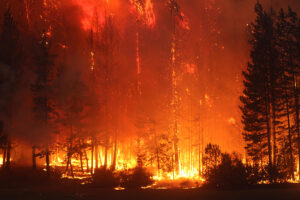
A flock of these hungry ungulates can turn an impassable thicket into an open glen in a matter of just one day. They will eat anything from grasses and thorn bushes to poison oak and small trees. Sheep are being used routinely to clear grasses and vines, while goats are chomping down low-hanging branches and intermediate growth. All of this hearty eating reduces the fire ladder by which flames travel from grasses to trees and then into the forest canopy.
With sheep and goats, the key to success is controlled grazing. The animals are contained in a designated area by a solar-charged, portable electric fence. The grazing time and the number of animals used varies, depending on the vegetation. In some areas, brush control can be achieved with 300 sheep on a single acre for one day.
Livestock growers are finding that herds for hire can be a reliable source of income. In northern California, Ann Pieschel, who owns Goats Unlimited, has all the work she can handle. She has contracts with private landowners, farmers, vineyard owners, and even some municipalities. The California office of the National Audubon Society is considering using goats to control invasive weeds on some of its preserves.
In the Stanislaus National Forest, the Forest Service is experimenting with goats to determine if they can be an ecologically benign way to reduce fire hazards. The agency is particularly interested in their use near communities and private property in order to avoid the inherent risks of prescribed fires.



